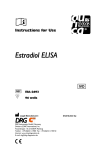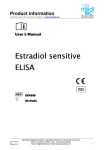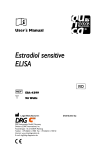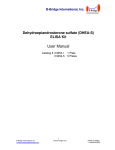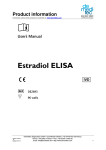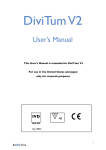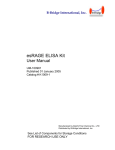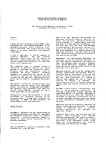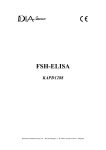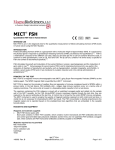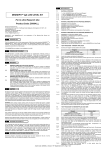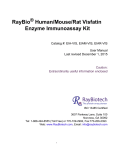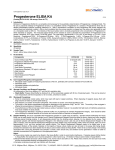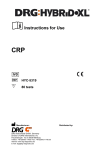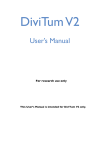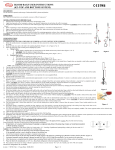Download IFU
Transcript
Estradiol (HYE-5349) USA: RUO As of 27 Nov. 2013 rm (Vers. 2.1) THIS KIT IS INTENDED FOR RESEARCH USE ONLY. NOT INTENDED FOR USE IN DIAGNOSTIC PROCEDURES. Intended Use The DRG:HYBRiD-XL Estradiol is an enzyme immunoassay for measurement of estradiol in serum and plasma. Only for use with the DRG:HYBRiD-XL Analyzer. 1 PRINCIPLE OF THE TEST The DRG:HYBRiD-XL Estradiol Kit is a solid phase enzyme-linked immunosorbent assay (ELISA) based on the principle of competitive binding. The antibody coated wells (ACW) of the reagent cartridges are coated with a polyclonal antibody directed towards a unique antigenic site of the estradiol molecule. Endogenous estradiol of a sample competes with an estradiol-horseradish peroxidase conjugate for binding to the coated antibody. After incubation the unbound conjugate is washed off. The amount of bound peroxidase conjugate is inversely proportional to the concentration of estradiol in the sample. Having added the substrate solution, the intensity of colour developed is inversely proportional to the concentration of estradiol in the sample. 2 WARNINGS AND PRECAUTIONS 1. For professional use only. 2. This kit can only be used in combination with the DRG:HYBRiD-XL Analyzer 3. Before starting the assay, read the instructions completely and carefully. Use the valid version of the package insert provided with the kit. Be sure that everything is clear and understood. 4. Do not remove, exchange, discard or damage any of the barcode labels provided with each kit and its components. All barcodes build an integral system for the kit lot. 5. Respect the general safety measures for use of laboratory reagents. 6. All reagents of this test kit which contain human serum or plasma have been tested and confirmed negative for HIV I/II, HBsAg and HCV by FDA approved procedures. All reagents, however, should be treated as potential biohazards in use and for disposal. 7. Never pipet by mouth and avoid contact of reagents and specimens with skin and mucous membranes. 8. Do not smoke, eat, drink or apply cosmetics in areas where specimens or kit reagents are handled. 9. Wear appropriate disposable gloves when handling specimens and reagents. Microbial contamination of reagents or specimens may cause false results. 10. Handling should be done in accordance with the procedures defined by an appropriate national biohazard safety guideline or regulation. 11. Do not use reagents beyond expiry date as shown on the kit labels. 12. Unused reagent cartridges must be stored at 2 °C to 8 °C in the sealed foil pouch with desiccant provided. 13. Optimal test results are only obtained when using calibrated pipettes. 14. Do not mix or use components from kits with different lot numbers. It is advised not to interchange reagent cartridges of different kits even of the same lot. The kits may have been shipped or stored under different conditions and the binding characteristics of the wells in the reagent cartridges may differ slightly. DRG International, Inc., USA Fax: (973) 564 7556 e-mail: [email protected] 1 Estradiol (HYE-5349) USA: RUO As of 27 Nov. 2013 rm (Vers. 2.1) 15. Some reagents contain Proclin 300, BND and/or MIT as preservatives. In case of contact with eyes or skin, flush immediately with water. 16. TMB substrate has an irritant effect on skin and mucosa. In case of possible contact, wash eyes with an abundant amount of water and skin with soap and plenty of water. Wash contaminated objects before reusing them. If inhaled, take the person to open air. 17. Chemicals and prepared or used reagents have to be treated as hazardous waste according to the national biohazard safety guidelines or regulations. 18. For information on hazardous substances included in the kit please refer to Safety Data Sheets. For professional users the Safety Data Sheet for this product is available upon request directly from DRG. 3 REAGENTS 3.1 Reagents provided 3.1.1 Reagent Cartridges 40 pieces containing the following: Antibody Coated Well (ACW) coated with anti-estradiol antibody (polyclonal). Enzyme Conjugate, 260 µL, estradiol antigen conjugated with horseradish peroxidase; Contains non-mercury preservative. Substrate Solution, 260 µL Tetramethylbenzidine (TMB). 3.1.2 Re-Calibrator 1 & 2 2 vials, 1 mL each, ready to use; For re-calibration of the quantitative DRG:HYBRiD-XL Estradiol test. Concentrations are lot-specific. Conversion: 1 pg/mL = 3.67 pmol/L Contain non-mercury preservative. 3.1.3 Control 1 & 2 2 vials, 1 mL each, ready to use; For control values and ranges please refer to the bar code on vial label or to the QC-Datasheet. Contain non-mercury preservative. DRG International, Inc., USA Fax: (973) 564 7556 e-mail: [email protected] 2 Estradiol (HYE-5349) USA: RUO As of 27 Nov. 2013 rm (Vers. 2.1) 3.2 Materials required but not provided General needed laboratory equipment Ultra-pure water DRG recommends to use Clinical Laboratory Reagent Water (CLRW) according to CLSI guideline 3C-A4 with the following specifications: Resistivity at 25 °C [MΩ·cm]: > 10 Conductivity at 25 °C [μS·cm−1]: < 0.1 Total Organic Carbon/p.p.b.(μg/L) : < 50 Colloids [μg/mL]: <0.05 REF HYB-5252 DRG:HYBRiD-XL Analyzer REF HYI-5392: System Solution 5L, 5000 mL; (Instrument Feed Water according to CLSI guideline 3C-A4 with the following specification can also be used: Resistivity at 25 °C [MΩ·cm]: > 1 Conductivity at 25 °C [μS·cm−1]: < 1 Total Organic Carbon/p.p.b.(μg/L) : < 200 Colloids [μg/mL]: <0.1) REF HYI-5394: Wash Buffer, 40x concentrate, 25 mL REF HYI-5395: Needle Cleaning Solution, 30 mL. Cleaning solution for the pipetting needle (daily and weekly maintenance, see also user manual) REF HYI-5387: Cuvettes, (2 x 360 pieces) For use of the Secondary Sample Holder for secondary tubes the following tubes are required: REF HYI-5391: Sample Tubes (Secondary), 2500 pcs. 3.3 Storage Conditions When stored at 2 °C to 8 °C, unopened reagents will retain reactivity until expiration date. Do not use reagents beyond this date. Opened reagents and the reagent cartridges must be stored at 2 °C to 8 °C. Once the foil bag has been opened, care should be taken to tightly close it again. Opened kits retain activity for three months if stored as described above. 3.4 Reagent Preparation Bring all reagents, such as controls and re-calibrators, to room temperature (20 °C to 25 °C) prior to use. Reagent Cartridges can be used directly after storage in the refrigerator. Wash Buffer (not included in the kit) For Wash Buffer (1x) dilute 25 mL of Wash Buffer (40x) with 975 mL ultra-pure water to a final volume of 1000 mL. The diluted Wash Buffer (1x) is stable for 2 weeks at room temperature. DRG International, Inc., USA Fax: (973) 564 7556 e-mail: [email protected] 3 Estradiol (HYE-5349) USA: RUO As of 27 Nov. 2013 rm (Vers. 2.1) 3.5 Disposal of the Kit The disposal of the kit and all used materials/reagents must be performed according to the national regulations. Special information for this product is given in the Safety Data Sheet. 3.6 Damaged Test Kits In case of any damage to the test kit or components, DRG must be informed in writing, at the latest one week after receiving the kit. Damaged single components should not be used for a test run. They have to be stored until a final solution has been found. After this, they should be disposed of according to the official regulations. 4 SPECIMEN COLLECTION AND PREPARATION Serum or plasma (EDTA-, heparin- or citrate plasma) can be used in this assay. A minimum of 85 µL of sample is needed for one determination. This includes 25 µL sample and 60 µL dead volume. Attention: This test was not verified with blood collection tubes of all available manufacturers. Sample Collection Systems of some manufacturers may contain different materials which in isolated cases could affect the test results. If primary tubes for sample collection are used, please follow the instructions of the manufacturer. Do not use haemolytic, icteric or lipaemic specimens. Samples containing precipitates have to be centrifuged prior to the test run. Do not use heat inactivated samples. Do not use standards or external controls stabilized with azide. 4.1 Specimen Collection Serum: Collect blood by venipuncture (e.g. Sarstedt Monovette for serum), allow to clot, and separate serum by centrifugation at room temperature. Do not centrifuge before complete clotting has occurred. Presence of anticoagulant may require increased clotting time. Plasma: Whole blood should be collected into centrifuge tubes containing anti-coagulant (e.g. Sarstedt Monovette with the appropriate plasma preparation) and centrifuged immediately after collection. 4.2 Specimen Storage and Preparation Specimens should be capped and may be stored for up to 7 days at 2 °C to 8 °C prior to performing the assay. Specimens stored for a longer time (up to one year) should be frozen at -20 °C prior to the assay (3 freeze / thaw cycles are possible). Thawed samples should be inverted several times prior to testing. 4.3 Specimen Dilution 4.3.1 Manual Sample Dilution If in an initial assay, a specimen is found to contain more than the highest standard, the specimens can be diluted with Sample Diluent* and reassayed as described in Assay Procedure. For the calculation of the concentrations this dilution factor has to be taken into account. DRG International, Inc., USA Fax: (973) 564 7556 e-mail: [email protected] 4 Estradiol (HYE-5349) USA: RUO As of 27 Nov. 2013 rm (Vers. 2.1) Example: a) dilution 1:10: 10 µL sample + 90 µL Sample Diluent (mix thoroughly) b) dilution 1:100: 10 µL dilution a) 1:10 + 90 µL Sample Diluent (mix thoroughly). * Sample Diluent for manual dilution is not included in this kit, but can be ordered on request. 5 ASSAY PROCEDURE 5.1 General Remarks All reagents, such as controls and re-calibrators and specimens, must be allowed to come to room temperature (20 °C to 25 °C) before use. All reagents and samples must be mixed without foaming. Reagent Cartridges can be used directly after storage in the refrigerator. Once the test has been started, all steps should be completed without interruption. Samples, controls and re-calibrators should be measured within 2 hours in order to avoid possible evaporation effects. The Secondary Sample Holder (HYI-5437) for secondary tubes has the capacity for a maximum of 20 samples including controls and re-calibrators. They all have to be pipetted into the secondary tubes, and the respective barcodes of control/re-calibrator vials and, if available, the sample barcodes have to be read with the external barcode scanner. 5.2 Test Procedure To ensure proper operation of the test, the instructions in the user manual for the DRG:HYBRiD-XL should strictly be followed. All test specific information required for the correct operation is included in the respective barcodes of the reagents. Take care not to damage these bar codes! It is recommended to tap the bottom of the Cartridge Segments containing the reagent cartridges once on the bench before placing them on the rotor. This is to avoid foam and adhering of the liquid on the sealing of the reagent cartridge. Place reagent cartridges on the rotor of the unit. The heating to 37 °C incubation temperature is performed automatically in the unit. 5.3 Calibration Traceability: This method was standardized against the DRG Estradiol ELISA (EIA-2693). Each DRG:HYBRiD-XL reagent contains a barcode with the specific information for recalibration of the reagent lot. The Master Curve is printed as a 2-D barcode on the outer label of the kit package and on the QC-Datasheet and has to be scanned with the external barcode scanner prior to the first use of the respective kit lot. Recalibration is recommended: if one or both assay controls are found outside the specified range. after 4 weeks of use of the same reagent kit on the unit. 5.4 Calculation of Results The analyte concentrations are calculated automatically by the DRG:HYBRiD-XL’s system software. DRG International, Inc., USA Fax: (973) 564 7556 e-mail: [email protected] 5 Estradiol (HYE-5349) USA: RUO As of 27 Nov. 2013 rm (Vers. 2.1) 6 QUALITY CONTROL It is recommended to use control samples according to state and federal regulations. The use of control samples is advised to assure the day to day validity of results. Apply appropriate statistical methods for analysing control values and trends. Please check the following: expiration dates and storage conditions of reagents, operational reliability of the analyser. In addition, it is indicated to perform a Recalibration. In case of further questions please contact your local distributor or DRG directly. 6.1 Internal Controls For Quality Control it is necessary to use the two internal controls provided with each kit. Acceptance ranges for both internal controls (Control 1 & 2) were established by the manufacturer and are summarized in the QC-Datasheet added to the kit. Note that the expected values and acceptance ranges stated in the QC-Datasheet always refer to the current kit lot. Internal controls should be run in single determination: on a routine basis (e.g. once per 24 h) if re-calibration is required (if one or both internal controls are out of range) if a new kit lot is used (in order to avoid any negative impact on the kit performance by improper transport or to detect improper storage during transport). 6.2 External Controls Use controls at both normal and pathological levels. The control intervals and control ranges for external controls should be adapted to the individual requirements of each laboratory. All results must be within the defined limits. Each laboratory should establish corrective measures to be taken if values of external controls are not found in the acceptance range. 7 LIMITATIONS OF USE Adhere to good laboratory practice. Any improper handling of samples or modification of this test might influence the results. 8 LEGAL ASPECTS 8.1 Reliability of Results The test must be performed exactly as per the manufacturer’s instructions for use. Moreover, the user must strictly adhere to the rules of GLP (Good Laboratory Practice) or other applicable national standards and/or laws. This is especially relevant for the use of control reagents. It is important to always include, within the test procedure, a sufficient number of controls for validating the accuracy and precision of the test. The test results are valid only if all controls are within the specified ranges and if all other test parameters are also within the given assay specifications. In case of any doubt or concern please contact DRG. DRG International, Inc., USA Fax: (973) 564 7556 e-mail: [email protected] 6 Estradiol (HYE-5349) USA: RUO As of 27 Nov. 2013 rm (Vers. 2.1) 8.2 Liability Any modification of the test kit and/or exchange or mixture of any components of different kit lots could negatively affect the intended results and validity of the overall test. Such modification and/or exchanges invalidate any claim for replacement. Claims submitted due to customer misinterpretation of laboratory results are invalid. Regardless, in the event of any claim, the manufacturer’s liability is not to exceed the value of the test kit. Any damage caused to the test kit during transportation is not subject to the liability of the manufacturer. For further information please refer to the User Manual of the DRG:HYBRiD-XL, analyser-specific application sheets, product information and package inserts of all necessary components. 9 REFERENCES 1. Tsang, B.K., Armstrong, D.T. and Whitfield, J.F., Steroid biosyntheses by isolated human ovarian follicular cells in vitro, J. Clin. Endocrinol. Metab. 51:1407 - 11 (1980). 2. Gore-Langton, R.E. and Armstrong, D.T., Follicular steroidogenesis and its control. In: The physiology of Reproduction, Ed.: Knobil, E., and Neill, J. et al., pp. 331-85. Raven Press, New York (1988). 3. Hall, P.F., Testicular Steroid Synthesis: Organization and Regulation. In: The Physiology of Reproduction, Ed.: Knobil, E., and Neill, J. et al., pp 975-98. Raven Press, New York (1988). 4. Siiteri, P.K. Murai, J.T., Hammond, G.L., Nisker, J.A., Raymoure, W.J. and Kuhn, R.W., The serum transport of steroid hormones, Rec. Prog. Horm. Res. 38:457 - 510 (1982). 5. Martin, B., Rotten, D., Jolivet, A. and Gautray, J-P-. Binding of steroids by proteins in follicular fluid of the human ovary, J.Clin. Endocrinol. Metab. 35: 443-47 (1981). 6. Baird, D.T., Ovarian steroid secretion and metabolism in women. In: The Endocrine Function of the Human Ovary. Eds.: James, V.H:T., Serio, M. and Giusti, G. pp. 125-33, Academic Press, New York (1976). 7. McNastty, K.P., Baird, D.T., Bolton, a., Chambers, P., Corker, C.S. and McLean, H., concentration of oestrogens and androgens in human ovarian venous plasma and follicular fluid throughout the menstrual cycle, J. Endocrinol. 71:7785 (1976). 8. Abraham, G.E., Odell, W.D., Swerdloff, R.S., and Hopper, K., Simultaneous radioimmunoassay of plasma FSH, LH, progesterone, 17-hydroxyprogesterone and estradiol-17ß during the menstrual cycle, J.Clin. Endocrinol. Metab. 34:312-18 (1972). 9. March, C.M., Goebelsmann, U., Nakumara, R.M., and Mishell, D.R., Roles of oestradiol and progesterone in eliciting midcycle luteinising hormone and follicle stimulating hormone surges. J. Clin. Endicrinol. Metab. 49:507-12 (1979). 10. Simpson, E.R., and McDonald, P.C., Endocrinology of Pregnancy. In: Textbook of Endocrinology, Ed.: Williams, R.H. pp412-22, Saunders Company, Philadelphia (1981). 11. Jenner, M.R., Kelch, R.P., et al., Hormonal Changes in prepubertal children, pubertal females and in precocious puberty, premature thelarche, hypogonadism and in a child with feminising tumour, J. Clin. Endocrinol. 34: 521 (1982). 12. Goldstein, D. et al., Correlation between oestradiol and progesterone in cycles with luteal phase deficiency, Fertil. Steril. 37: 348-54 (1982). DRG International, Inc., USA Fax: (973) 564 7556 e-mail: [email protected] 7 Estradiol (HYE-5349) USA: RUO As of 27 Nov. 2013 rm (Vers. 2.1) 13. Kirschner, M.A., therole of hormones in the etiology of human breast cancer, Cancer 39:2716 26 (1977). 14. Odell, W.D. and Swerdloff, R.D., Abnormalities of gonadal function in men, Clin. Endocr. 8:149-80 (1978). 15. McDonald, P.c., Madden, J.C., Brenner, P.F., Wilson, J.D. and Siiteri, P.K. Origin of oestrogen in normal men and women with testicular feminisation, J.Clin. Endcrinol. Metabol. 49:905 (1979). 16. Peckham, M.J: and McElwain, T.J:, Testicular tumours, J.Clin. Endocrinol. Metab. 4:665-692 (1975). 17. Taubert, H.d. and Dericks-Tan, J.s.E., Induction of ovulation by clomiphene citrate in combination with high doses of oestrogens or nasal application of LH-RH. In: Ovulation in the Human. Eds.: Crosignandi, P.G. and Mishell, D.R., pp.265-73, Academic Press, New York (1976). 18. Fishel, S.B., Edwards, R.G., Purdy, J.M., Steptoe, P.C., Webster, J. Walters, E., cohen, J. Fehilly, C. Hewitt, J., and Rowland, G., Implantation, abortion and birth after in-vitro fertilisation using the natural menstrual cycle or follicular stimulation with clomiphene citrate and human menopausal gonadotropin, J. In Vitro Fertil. Embryo Transfer, 1:2428 (1985). 19. Wramsby, H., Sundstorm, P- and Leidholm, P., Pregnancy rate in relation to number of cleaved eggs replaced after in vitro-fertilisation of stimulating cycles monitored by serum levels of oestradiol and progesterone as sole index. Human Reproduction 2: 325-28 (1987). 20. Ratcliff, W.A.., Carter, G.D., et al., Estradiol assays: applications and guidelines for the provision of clinical biochemistry service, Ann. Clin. Biochem. 25:466-483 (1988). 21. Tietz, N.W. Textbook of Clinical Chemistry. Saunders, 1986. Rev. 11/12/13cc DRG International, Inc., USA Fax: (973) 564 7556 e-mail: [email protected] 8









